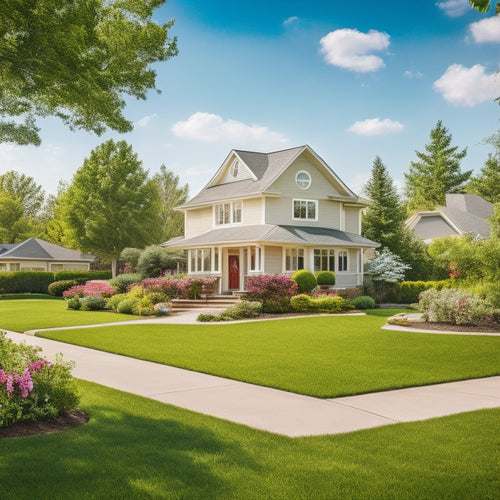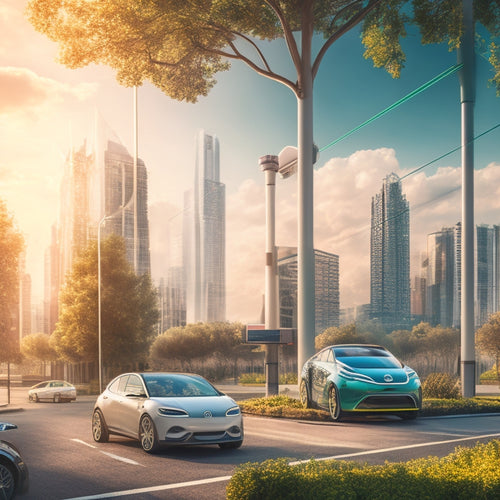
Green City Transport Systems for Future Mobility
Share
As you envision a future where cities thrive without harming the environment, you're likely considering the vital role that green city transport systems will play in reducing emissions and improving air quality. You'll need to integrate electric buses into public transportation networks, prioritize green infrastructure like urban forestry and park connectivity, and design smart traffic management systems. Additionally, you'll want to explore eco-friendly roadway materials, bike-friendly city infrastructure, and pedestrian-centric urban design principles. As you explore these innovative strategies, you'll uncover a holistic approach to future mobility that balances human needs with environmental sustainability - and discover even more ways to shape the cities of tomorrow.
Key Takeaways
• Green city transport systems prioritize electrifying public transportation networks, integrating electric buses, and installing charging infrastructure.
• Urban planning incorporates green spaces, tree canopy coverage, and park connectivity networks to mitigate the urban heat island effect.
• Smart traffic management systems utilize real-time optimization, adaptive intersections, and traffic prediction modeling to reduce congestion.
• Eco-friendly road materials innovation focuses on sustainable pavement options, low-carbon asphalt mixes, and recycled materials to reduce emissions.
• Autonomous vehicle integration strategies involve upgrading traffic management systems, public education, and data-sharing protocols to optimize traffic flow.
Electrifying Public Transportation Networks
As you explore the concept of green city transport systems, electrifying public transportation networks becomes an essential step towards reducing emissions and minimizing environmental impact.
One of the most effective ways to achieve this is by integrating electric buses into your fleet. Electric buses offer a cleaner, quieter, and more efficient alternative to traditional fossil-fuel-powered buses.
However, to support the widespread adoption of electric buses, a thorough charging infrastructure is essential. You'll need to take into account the installation of charging stations at bus depots, terminals, and along bus routes. This infrastructure should be designed to accommodate the unique needs of electric buses, including high-power charging capabilities and smart grid integration.
Green Infrastructure for Urban Planning
As you design green infrastructure for urban planning, you'll focus on three key elements: urban green spaces, park connectivity networks, and tree canopy coverage.
You'll need to strategically integrate these components to create a sustainable and resilient urban ecosystem.
Urban Green Spaces
By incorporating green spaces into urban planning, cities can mitigate the urban heat island effect, reducing temperatures by up to 4°C and improving air quality. As you design urban green spaces, consider incorporating urban forestry. This involves strategically planting and maintaining trees to maximize their benefits. This can include shading streets, reducing stormwater runoff, and providing habitat for urban wildlife.
Green corridors, such as linear parks and greenways, can also be integrated into urban planning to create connectivity between green spaces and promote ecological corridors. By doing so, you can enhance biodiversity, improve air quality, and provide recreational spaces for residents.
Urban green spaces can also serve as natural buffers against extreme weather events, such as floods and heatwaves. By prioritizing green spaces in urban planning, you can create more resilient, sustainable, and livable cities.
Park Connectivity Networks
You can design park connectivity networks, a type of green infrastructure, to link fragmented green spaces and enhance ecological corridors within urban areas. By doing so, you'll create a seamless travel experience for both humans and wildlife. This network of interconnected parks and trails promotes biodiversity, reduces urban heat island effects, and increases air quality.
Imagine strolling through a vibrant green corridor, surrounded by lush vegetation and the sounds of nature. You can make this a reality by incorporating the following design elements:
-
Wide, accessible pathways that encourage walking and cycling
-
Native plant species that provide habitat for local wildlife
-
Trail integration that connects parks, schools, and community centers
-
Park access points with clear signage and wayfinding
-
Eco-friendly lighting that minimizes light pollution
Tree Canopy Coverage
Thirty percent of urban land should be dedicated to tree canopy coverage, an essential aspect of green infrastructure, to mitigate the urban heat island effect and improve air quality.
As you plan your city's transport system, you'll want to prioritize tree canopy coverage to create a more livable urban environment. Urban Forestry practices can help you achieve this goal by strategically planting and maintaining trees in your city.
By doing so, you'll not only reduce the urban heat island effect but also improve air quality, reduce noise pollution, and enhance biodiversity. This, in turn, will contribute to Climate Resilience, making your city more adaptable to the challenges posed by climate change.
To maximize the benefits of tree canopy coverage, you should consider integrating green roofs, green walls, and urban parks into your city's design. By doing so, you'll create a more sustainable, resilient, and healthy urban environment for your citizens.
Smart Traffic Management Systems Design
Designing smart traffic management systems requires integrating advanced technologies, such as real-time sensors and data analytics, to optimize traffic flow and minimize congestion. As you develop these systems, you'll need to take into account the complexities of urban traffic networks. By leveraging real-time data, you can optimize traffic signal control to reduce congestion and minimize travel times.
Here are some key features to take into account when designing smart traffic management systems:
-
Real-time optimization: Adjust traffic signal timing in real-time to respond to changing traffic conditions
-
Adaptive intersections: Implement intelligent traffic signals that adjust their timing based on traffic volume and pedestrian/bicycle traffic
-
Traffic prediction modeling: Use machine learning algorithms to predict traffic patterns and optimize traffic signal control
-
Real-time traffic monitoring: Utilize sensors and cameras to monitor traffic conditions in real-time
-
Dynamic lane management: Adjust lane usage in real-time to optimize traffic flow and reduce congestion
Eco-Friendly Roadway Materials Innovation
As you explore eco-friendly roadway materials, you'll find that sustainable pavement options are becoming increasingly viable.
You'll discover that low-carbon asphalt mix innovations are reducing the environmental impact of road construction.
Sustainable Pavement Options
By 2025, you'll likely be driving on roads paved with innovative, eco-friendly materials that reduce carbon footprint and minimize environmental impact. As cities shift towards sustainable transportation systems, the focus moves to sustainable pavement options. These eco-friendly materials not only reduce carbon emissions but also mitigate the urban heat island effect, improve air quality, and enhance urban aesthetics.
Some of the innovative pavement options you'll encounter include:
-
Porous Pavement: Allowing rainwater to percolate through the surface, reducing stormwater runoff and filtering pollutants.
-
Permeable Concrete: A highly porous material that enables water infiltration, reducing flood risk and urban drainage issues.
-
Recycled Glass Asphalt: A sustainable alternative to traditional asphalt, utilizing recycled glass as an aggregate.
-
Graphene-Enhanced Concrete: A cutting-edge material that enhances strength, durability, and thermal conductivity.
-
Bamboo-Based Pavement: A lightweight, durable, and sustainable option with a lower carbon footprint.
These sustainable pavement options will revolutionize urban transportation, creating a healthier, more environmentally friendly environment for you and future generations.
Low-Carbon Asphalt Mix
You'll soon be driving on roads paved with a new generation of low-carbon asphalt mixes that greatly reduce greenhouse gas emissions and environmental impact.
These innovative asphalt mixes are designed to minimize the carbon footprint of road construction and maintenance. By incorporating carbon sequestration technologies, these mixes can actually absorb more carbon dioxide from the atmosphere than they emit during production.
Asphalt innovations have led to the development of sustainable binders, such as bio-based asphalt, that replace traditional fossil-fuel-based binders. Additionally, the use of recycled materials and waste products in the asphalt mixture reduces the amount of virgin aggregate needed, further decreasing emissions.
The result is a significant reduction in greenhouse gas emissions throughout the entire lifecycle of the road, from production to end-of-life. As you drive on these roads, you'll be contributing to a cleaner, healthier environment, and paving the way for a more sustainable transportation system.
Recycled Material Potential
As you explore the world of eco-friendly roadway materials innovations, you'll discover the vast potential of recycled materials in asphalt mixes. Incorporating recycled materials into asphalt mixes not only reduces the environmental impact of road construction but also reveals a treasure trove of eco-friendly roadway materials innovations.
By embracing recycled materials, you're contributing to waste reduction and promoting a circular economy. This approach enables the creation of closed loops in supply chains, where materials are constantly cycled back into production.
Here are some exciting possibilities:
- Reclaimed asphalt pavement (RAP) is reused to reduce the demand for virgin aggregates
- Recycled concrete aggregate (RCA) is repurposed to decrease the need for new concrete production
- Waste plastics are transformed into durable, long-lasting road materials
- Reclaimed steel from old infrastructure is melted down to produce new reinforcement materials
- Biomass waste is converted into bio-asphalt, reducing dependence on fossil fuels
Bike-Friendly City Infrastructure Development
As you start developing a green city transport system, you'll want to focus on bike-friendly city infrastructure enhancement. Developing bike-friendly city infrastructure requires integrating dedicated bike lanes, traffic calming measures, and secure parking facilities to ensure a safe and convenient cycling experience.
By doing so, you'll greatly improve cycling safety, an important aspect of green urban planning. Dedicated bike lanes, for instance, provide a clear separation between cyclists and motorized traffic, reducing the risk of accidents and promoting a stress-free ride.
Traffic calming measures, such as speed bumps and chicanes, also play an essential role in maintaining a safe cycling environment. Additionally, secure parking facilities encourage cyclists to lock their bikes safely, reducing the likelihood of theft and vandalism.
Autonomous Vehicle Integration Strategies
As you begin incorporating autonomous vehicles into your green city transport system, you'll need to develop strategies that guarantee a smooth shift. In order to secure the seamless integration of autonomous vehicles into your green city transport system, it's vital to develop strategies that address infrastructure readiness, public education, and regulatory frameworks.
To create an efficient autonomous vehicle ecosystem, consider the following key elements:
-
Infrastructure Readiness: Upgrade traffic management systems and install dedicated lanes for autonomous vehicles to ensure smooth traffic flow.
-
Public Education: Launch public awareness campaigns to educate citizens about the benefits and limitations of autonomous vehicles, promoting trust and adoption.
-
Regulatory Frameworks: Collaborate with policymakers to establish clear guidelines and standards for the deployment of autonomous vehicles, ensuring safety and accountability.
-
Data Sharing: Establish data-sharing protocols between autonomous vehicles, infrastructure, and city authorities to optimize traffic management and urban scaling.
-
Cybersecurity: Implement robust cybersecurity measures to protect against potential threats and ensure the integrity of autonomous vehicle systems.
Pedestrian-Centric Urban Design Principles
Designing pedestrian-centric urban spaces requires careful consideration of human scale, accessibility, and safety, prioritizing pedestrian-friendly infrastructure that promotes walkability and community engagement.
As you plan and design urban areas, it's essential to prioritize the needs of pedestrians, ensuring they can navigate the space comfortably and safely. This means creating walkable neighborhoods with wide, well-maintained sidewalks, ample pedestrian crossings, and minimal obstacles.
You'll also want to incorporate street furniture, such as benches, bike racks, and waste receptacles, that enhance the pedestrian experience without obstructing the path. By doing so, you'll foster a sense of community and encourage social interaction among residents and visitors alike.
Moreover, pedestrian-centric design principles can help reduce traffic congestion, promote physical activity, and boost local businesses. By putting pedestrians first, you'll create vibrant, thriving urban spaces that benefit everyone.
Green Logistics and Delivery Hubs
Optimize your urban planning by integrating green logistics and delivery hubs, which can greatly reduce congestion and emissions by consolidating packages and streamlining transportation routes. This approach enables you to create a more efficient and sustainable urban transportation system. By centralizing logistics and delivery operations, you can reduce the number of vehicles on the road, resulting in lower emissions and decreased traffic congestion.
Here are some benefits of green logistics and delivery hubs:
-
Reduced carbon footprint: By consolidating packages and optimizing routes, you can notably decrease your carbon offset, making your city a more environmentally friendly place.
-
Increased efficiency: Green logistics and delivery hubs streamline the delivery process, reducing transportation times and costs.
-
Urban warehousing: By integrating urban warehousing into your logistics and delivery hubs, you can reduce the need for lengthy transportation routes, further decreasing emissions and congestion.
-
Improved air quality: With fewer vehicles on the road, you can expect enhanced air quality, making your city a healthier place to live.
-
Enhanced customer experience: Green logistics and delivery hubs enable faster and more reliable delivery times, leading to increased customer satisfaction.
Data-Driven Mobility Planning Tools
You can harness data-driven mobility planning tools to analyze the impact of green logistics and delivery hubs on your city's transportation network, identifying areas for further optimization and improvement. By integrating mobility analytics and data visualization, you can gain valuable insights into traffic patterns, congestion hotspots, and travel behavior. This information enables you to fine-tune your city's transportation infrastructure, optimizing routes, and schedules to reduce emissions and improve air quality.
Data-driven mobility planning tools also allow you to simulate different scenarios, testing the effects of various interventions on traffic flow and congestion. This predictive capability enables you to make data-informed decisions, prioritizing investments in infrastructure and services that will have the greatest impact on your city's transportation network.
With the power of data-driven insights, you can create a more efficient, sustainable, and resilient transportation system, supporting the well-being of citizens and the environment. By utilizing the potential of mobility analytics and data visualization, you can pave the way for a brighter, more sustainable future for your city.
Frequently Asked Questions
What Percentage of Greenhouse Gases Can Green Transport Systems Reduce?
"As you navigate the road to sustainability, imagine a carbon-neutral horizon, where green transport systems can reduce greenhouse gases by up to 70%. By investing in carbon offset initiatives, you'll be on track to meet emission targets, paving the way for a cleaner future."
Can Green City Transport Systems Be Implemented in Developing Cities?
When implementing green city transport systems in developing cities, you'll need to prioritize urban planning and infrastructure development, ensuring a cohesive approach that integrates sustainable transportation solutions with existing infrastructure, maximizing efficiency and minimizing costs.
How Do Green Transport Systems Impact Urban Air Quality Levels?
You'll find that adopting green transport systems greatly reduces air pollution, as they minimize vehicle emissions, ultimately decreasing urban air quality levels and creating a healthier environment for you and your community.
Are Green Transport Systems More Expensive Than Traditional Systems?
You're wondering if green transport systems break the bank? Consider this: Copenhagen's bike-share system, Bycyklen, costs $2.5 million annually, but attracts tourists, boosts local businesses, and reduces congestion, making it a valuable investment, despite being pricier than traditional transport.
Can Green Transport Systems Be Integrated With Existing Infrastructure?
As you consider integrating green transport systems, you'll face infrastructure challenges; however, by adopting innovative urban planning strategies, you can successfully merge new systems with existing infrastructure, ensuring a smooth shift to sustainable mobility.
Related Posts
-

What Does Solar Panel Maintenance Really Cost?
You can expect to pay between $1,500 to $2,500 per year for solar panel maintenance, with costs influenced by your sy...
-

7 Best Financial Incentives for Residential Homeowners
You're entitled to a range of financial incentives that can help offset the costs of owning a home, from federal tax ...
-

Designing Efficient Vehicle Charging Infrastructure Systems
As you design efficient vehicle charging infrastructure systems, prioritize strategic planning and optimization to av...


